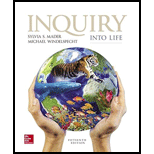
Inquiry into Life
15th Edition
ISBN: 9781259426162
Author: Sylvia S. Mader Dr., Michael Windelspecht
Publisher: McGraw-Hill Education
expand_more
expand_more
format_list_bulleted
Concept explainers
Question
Chapter 1, Problem 1CS
Summary Introduction
To analyze:
The basic characteristics that define life.
Introduction:
The ecosystem consists of both living and non-living things. Living things have a number of characteristics which easily distinguishes them from non-living things.
Expert Solution & Answer
Explanation of Solution
The basic characteristics that define life are listed below:
- Sensing the changes in the environment - The environment is not constant in nature. Living things have the capacity to sense differences in the environment. For example, the receptor organs can detect changes in the environment.
- Capability to grow and change form - Living things can grow through processes like cell division. Due to this growth, their morphological features change.
- Capability to reproduce and the production of offspring - Living things reproduce either sexually or asexually.
- Complex metabolic machinery - The overall enzyme-mediated
chemical reactions that include synthetic (anabolism) and destructive processes (catabolism) are known asmetabolism . For example, the process of photosynthesis,cellular respiration , etc. are the processes of metabolic reactions. - Mechanisms to maintain homeostasis - The maintenance of a constant interval environment regardless of the changing environment are termed as homeostasis.
- Cellular makeup − All life forms from unicellular to multicellular, either plants or animal and even microbes are anatomically made up of cells. Cells are the basic structural and functional unit of life.
- Passing on genetic traits to young ones - As traits are determined by genes, the offspring possess a combination of characteristics of the parents.
Conclusion
Sensing changes in the environment, the capability to grow and change form, the capability to reproduce and the production of offspring, complex metabolic machinery, mechanisms to maintain homeostasis, cellular makeup, and passing on genetic traits to young ones are the basic characteristics that define life.
Want to see more full solutions like this?
Subscribe now to access step-by-step solutions to millions of textbook problems written by subject matter experts!
Chapter 1 Solutions
Inquiry into Life
Ch. 1.1 - Identify the basic characteristics of life.Ch. 1.1 - Distinguish between the levels of biological...Ch. 1.1 - Recognize the importance of adaptation and...Ch. 1.1 - What other environments do you think could be...Ch. 1.1 - In addition to hemoglobin levels, do you think...Ch. 1.1 - List the common characteristic of all living...Ch. 1.1 - Prob. 2CYPCh. 1.1 - Explain how adaptations relate to evolutionary...Ch. 1.1 - Prob. 1ACh. 1.1 - Prob. 2A
Ch. 1.1 - The process that involves passing on genetic...Ch. 1.2 - Describe how living organisms are classified.Ch. 1.2 - Distinguish between the three domains of life.Ch. 1.2 - Prob. 1CYPCh. 1.2 - List the levels of taxonomic classification from...Ch. 1.2 - Explain why scientists assign species to a...Ch. 1.2 - 4. Which of the following includes prokaryotic...Ch. 1.2 - Prob. 5ACh. 1.2 - Prob. 6ACh. 1.3 - Identify the components of the scientific method.Ch. 1.3 - Distinguish between a theory and a hypothesis.Ch. 1.3 - Prob. 3LOCh. 1.3 - Identify the role of the experimental variable in...Ch. 1.3 - Distinguish between the roles of the test group...Ch. 1.3 - Prob. 3CYPCh. 1.3 - Prob. 7ACh. 1.3 - Prob. 8ACh. 1.3 - Prob. 9ACh. 1.4 - Distinguish between science and technology.Ch. 1.4 - Summarize some of the major challenges facing...Ch. 1.4 - Explain how a new technology differs from a...Ch. 1.4 - Prob. 2CYPCh. 1.4 - Summarize how emerging diseases and climate change...Ch. 1.4 - Prob. 10ACh. 1.4 - Prob. 11ACh. 1.4 - Prob. 12ACh. 1 - Prob. 1CSCh. 1 - Prob. 2CSCh. 1 - What does it tell us if we discover life on one of...Ch. 1 - 1. Explain how model organisms make the study of...Ch. 1 - Suppose that we find a form of life on another...Ch. 1 - 3. You are a scientist working at a pharmaceutical...
Knowledge Booster
Learn more about
Need a deep-dive on the concept behind this application? Look no further. Learn more about this topic, biology and related others by exploring similar questions and additional content below.Recommended textbooks for you
 Human Anatomy & Physiology (11th Edition)BiologyISBN:9780134580999Author:Elaine N. Marieb, Katja N. HoehnPublisher:PEARSON
Human Anatomy & Physiology (11th Edition)BiologyISBN:9780134580999Author:Elaine N. Marieb, Katja N. HoehnPublisher:PEARSON Biology 2eBiologyISBN:9781947172517Author:Matthew Douglas, Jung Choi, Mary Ann ClarkPublisher:OpenStax
Biology 2eBiologyISBN:9781947172517Author:Matthew Douglas, Jung Choi, Mary Ann ClarkPublisher:OpenStax Anatomy & PhysiologyBiologyISBN:9781259398629Author:McKinley, Michael P., O'loughlin, Valerie Dean, Bidle, Theresa StouterPublisher:Mcgraw Hill Education,
Anatomy & PhysiologyBiologyISBN:9781259398629Author:McKinley, Michael P., O'loughlin, Valerie Dean, Bidle, Theresa StouterPublisher:Mcgraw Hill Education, Molecular Biology of the Cell (Sixth Edition)BiologyISBN:9780815344322Author:Bruce Alberts, Alexander D. Johnson, Julian Lewis, David Morgan, Martin Raff, Keith Roberts, Peter WalterPublisher:W. W. Norton & Company
Molecular Biology of the Cell (Sixth Edition)BiologyISBN:9780815344322Author:Bruce Alberts, Alexander D. Johnson, Julian Lewis, David Morgan, Martin Raff, Keith Roberts, Peter WalterPublisher:W. W. Norton & Company Laboratory Manual For Human Anatomy & PhysiologyBiologyISBN:9781260159363Author:Martin, Terry R., Prentice-craver, CynthiaPublisher:McGraw-Hill Publishing Co.
Laboratory Manual For Human Anatomy & PhysiologyBiologyISBN:9781260159363Author:Martin, Terry R., Prentice-craver, CynthiaPublisher:McGraw-Hill Publishing Co. Inquiry Into Life (16th Edition)BiologyISBN:9781260231700Author:Sylvia S. Mader, Michael WindelspechtPublisher:McGraw Hill Education
Inquiry Into Life (16th Edition)BiologyISBN:9781260231700Author:Sylvia S. Mader, Michael WindelspechtPublisher:McGraw Hill Education

Human Anatomy & Physiology (11th Edition)
Biology
ISBN:9780134580999
Author:Elaine N. Marieb, Katja N. Hoehn
Publisher:PEARSON

Biology 2e
Biology
ISBN:9781947172517
Author:Matthew Douglas, Jung Choi, Mary Ann Clark
Publisher:OpenStax

Anatomy & Physiology
Biology
ISBN:9781259398629
Author:McKinley, Michael P., O'loughlin, Valerie Dean, Bidle, Theresa Stouter
Publisher:Mcgraw Hill Education,

Molecular Biology of the Cell (Sixth Edition)
Biology
ISBN:9780815344322
Author:Bruce Alberts, Alexander D. Johnson, Julian Lewis, David Morgan, Martin Raff, Keith Roberts, Peter Walter
Publisher:W. W. Norton & Company

Laboratory Manual For Human Anatomy & Physiology
Biology
ISBN:9781260159363
Author:Martin, Terry R., Prentice-craver, Cynthia
Publisher:McGraw-Hill Publishing Co.

Inquiry Into Life (16th Edition)
Biology
ISBN:9781260231700
Author:Sylvia S. Mader, Michael Windelspecht
Publisher:McGraw Hill Education
Bacterial Genomics and Metagenomics; Author: Quadram Institute;https://www.youtube.com/watch?v=_6IdVTAFXoU;License: Standard youtube license